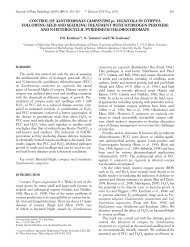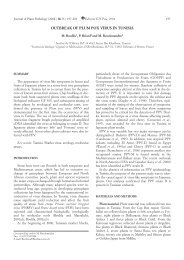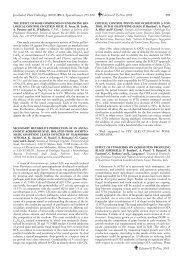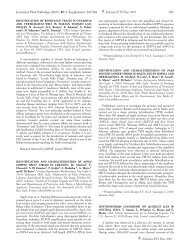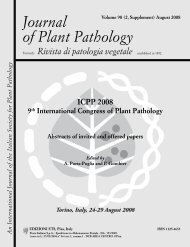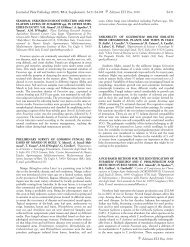Journal of Plant Pathology - Sipav.org
Journal of Plant Pathology - Sipav.org
Journal of Plant Pathology - Sipav.org
Create successful ePaper yourself
Turn your PDF publications into a flip-book with our unique Google optimized e-Paper software.
S1.8 Fungicide sensitivity <strong>of</strong> Septoria tritici <strong>Journal</strong> <strong>of</strong> <strong>Plant</strong> <strong>Pathology</strong> (2011), 93 (1, Supplement), S1.7-S1.13<br />
sensitivity <strong>of</strong> fungi towards DMIs (Leroux et al., 2007).<br />
Furthermore, experimental evidence suggests that ABC<br />
(ATP-Binding Casette)-transporters located in the outer<br />
membrane <strong>of</strong> fungal cells are involved in fungicide resistance<br />
<strong>of</strong> S. tritici by exporting the toxic compounds<br />
(Stergiopoulos et al., 2003). DMIs were first introduced<br />
in the 1970s (prochloraz 1977, propiconzole 1979, tebuconazole<br />
1986, epoxiconazole 1990, and prothioconazole<br />
2002; Russell, 2005).<br />
In contrast to DMIs and QoIs, folpet and<br />
chlorothalonil are non-systemic fungicides that are not<br />
taken up by the plant in significant amounts (Tomlin,<br />
2000). They belong to the group <strong>of</strong> multi-site inhibitors,<br />
which interfere with various steps <strong>of</strong> fungal metabolism<br />
(Tomlin, 2000). Folpet and chlorothalonil were introduced<br />
in 1952 and 1964, respectively (Russell, 2005).<br />
Northern Germany is a region with high yield/cropping<br />
potential with an average yield <strong>of</strong> about 9 tons<br />
wheat per ha (Stratmann et al., 2004). For comparison,<br />
wheat yield was reported to be about 3 tons per ha for<br />
the USA (OSU, 2007). The high levels <strong>of</strong> yield result<br />
from fertile soil and sufficient rain on the one hand but<br />
also from high inputs <strong>of</strong> fertilizers, pesticides, and labor<br />
on the other hand. However, regular precipitation favors<br />
the development <strong>of</strong> fungal populations in the field and<br />
results in high disease pressure in most years (Ceynowa et<br />
al., 1993; Verreet et al., 2000). Since fungicide resistance<br />
probably develops in regions with high application frequencies<br />
and low doses, fungicide resistance monitoring<br />
and resistance management is particularly important in<br />
these regions (Staub, 1991). Since the breakdown <strong>of</strong> QoI<br />
efficacy, control <strong>of</strong> S. tritici depends almost solely on<br />
azoles. Resistance management by alternating effective<br />
fungicides with different modes <strong>of</strong> action is therefore extraordinarily<br />
difficult with this pathogen.<br />
It was the objective <strong>of</strong> the present study to determine<br />
the recent trend in sensitivity <strong>of</strong> S. tritici toward selected<br />
systemic azoles, a strobilurin and non-systemic contact<br />
fungicides in a region with high yield and frequent use<br />
<strong>of</strong> fungicides.<br />
incubation period and the spores were diluted with sterilized<br />
deionized water and transferred to plates containing<br />
malt yeast extract agar (MYA, yeast extract, glucose,<br />
malt extract, each component at 4 g l -1 plus 15 g l -1<br />
agar). Colonies originating from a single spore were<br />
transferred to new MYA plates and the spores produced<br />
on that plate were washed <strong>of</strong>f using 10% [w/v] sterile<br />
skim milk and stored at -70°C until further use. Spores<br />
used in the bioassays described below always originated<br />
directly from the stock solution stored at -70°C. Fungal<br />
strains transferred from plate to plate quickly ceased<br />
spore production and grew as mycelium which was less<br />
suitable for our bioassay due to its heterogeneity in liquid<br />
media compared to the spores. Spores from the<br />
stock solution were transferred to MYA plates and the<br />
liquid was distributed over the medium surface using a<br />
sterile triangle-shaped metal spreader rod. After 4 days<br />
at room temperature, propagation <strong>of</strong> the spores resulted<br />
in spore clusters that were washed <strong>of</strong>f using sterile<br />
deionized water and the spore concentrations <strong>of</strong> the solutions<br />
were determined using a Fuchs Rosenthal<br />
haemocytometer and a light microscope. The optical<br />
density <strong>of</strong> the same solutions was measured (Fluorescence,<br />
absorbance and luminescence reader, model Genios,<br />
Tecan Group, Switzerland) in the absorbance<br />
mode at 595 nm with a shaking period <strong>of</strong> 5 sec prior to<br />
measurements. Solutions for bioassays were diluted to<br />
approximately 500,000 spores per ml by measuring the<br />
optical density <strong>of</strong> a subsample <strong>of</strong> the spore suspension<br />
using the relationship depicted in Fig. 1. The number <strong>of</strong><br />
isolates available for our study were 7, 2, and 7 in 1999,<br />
2004, and 2008, respectively.<br />
Bioassays. Fungicides were either purchased from<br />
Sigma-Aldrich, Switzerland (trifloxystrobin), Fein-<br />
MATERIALS AND METHODS<br />
Fungal strains. Wheat plants (susceptible cv. Ritmo)<br />
with typical Septoria tritici necroses were sampled at<br />
growth stages 21-32 (Zadoks et al., 1974) in Northern<br />
Germany (federal state Schleswig-Holstein, area between<br />
53.70 and 54.38°N latitude and 8.83 and 10.88°E<br />
longitude) in 1999, 2004, and 2008. <strong>Plant</strong>s were stored<br />
at -20°C until further analysis. After defrosting, leaves<br />
were inspected for Septoria tritici pycnidia under a<br />
binocular microscope and leaf pieces (approximately 2<br />
cm in length) with pycnidia were incubated in Petri<br />
dishes on water agar (1.5% [w/w]) for 24 h at room<br />
temperature. Pycnidia discharged spore slime during the<br />
Fig. 1. Relationship between Septoria tritici spore concentration<br />
in deionized water and optical density [measured in absorbance<br />
(dimensionless) mode at a wavelength <strong>of</strong> 595 nm,<br />
with 200 µl in 96 microtiterplate wells]. The vertical dashed<br />
line indicates the optical density <strong>of</strong> an empty plate.



